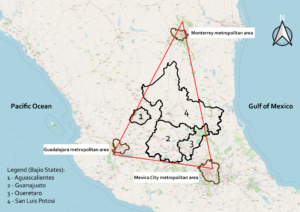This blog was written for the RSA Blog Student Summer Series that will highlight graduate student success in regional studies across the globe throughout the summer.
Mexico has vast cultural, geographical, and economic features across its regions. Since the NAFTA was signed by the United States, Mexico, and Canada, foreign investment and industry have had a crucial relevance not only in the industrial policies but in the national economic dynamic itself. The industry had been traditionally located in the north of Mexico, particularly in the border cities e.g., Tijuana, Ciudad Juarez, and Reynosa for an economy based on exports and their geographical proximity to the US.

Industry and foreign investment relocation
According to Trejo, this path showed a logic of industry relocation from the traditional center in Mexico City to the north in the frame of the import substitution model ending. There is also evidence of an additional process of relocation from the northern regions to the center due to the economic crisis in 2008, and the violence crisis in 2010. This caused the industry and qualified workers to emigrate and to install in cities with economic and population growth such as Leon, Queretaro, and Aguascalientes, but smaller than the Metropolitan areas e.g., Mexico City, Guadalajara, Monterrey.
Thus, the Bajio region integrates Aguascalientes, Guanajuato, Queretaro, and San Luis Potosi states into a region that shares economic activities, institutional arrangements and develops high connectivity and infrastructure between their main cities. While in the last century the northern regions were the most profited with industrial establishments, there has been a change in the past decade, particularly since 2010. The Secretary of Economy has reported an accumulated foreign investment flow of 37 613.9 million dollars from 2004 to 2019 in the Bajio, and 65.9 percent of those totals correspond only to the manufacturing industry.
Economic growth and localization factors of the Bajio
To this point, it might seem counter theoretical that a region located at least 1 500 kilometers far from the border between Mexico and the US – Mexico’s main trading partner –, has grown so fast and with an average variation of 4.7 percent in the Gross Domestic Product (GDP) each year from 2003 to 2018, in accordance with data of the National Institute of Statistics and Geography (INEGI). Moreover, in 2010, the Bajio had a GDP growth rate of 15.1 percent, recovering faster from the 2008 crisis, than northern states like Nuevo Leon (11.1%), Sonora (6.2%), and Chihuahua (6.1%). It is also remarkable that Aguascalientes was the state that grew the most, with 22.5 percent of expansion only in that year.
The foreign investment concentrates in the subsector 336 of transportation equipment manufacturing (see image above). Nevertheless, the entire industrial sector 31-33 has contributed to the economic growth of the region, due to its supply chains and the geographical proximity of the main and capital cities of the region. For instance, the Bajio Industrial Logistics Corridor was consolidated in 2015, starting in Leon, Guanajuato, and linking Silao, Irapuato, Salamanca, and Celaya, to end in Queretaro. There is as well the thought of the Bajio is in a sort of triangle between the top three metropolitan areas of Mexico, the Pacific Ocean, and the Gulf of Mexico. This geographical position is vital for its regional dynamics.

Spatial and Regional Economics
Yet the growth in the Bajio is a sum of its privileged location, its institutions, and the policies of both national and state governments. These factors have had a significant impact on the industry arrival and the regional competitiveness. This makes sense to the contributions of Sobrino on the interrelation of economics and territory as of the industrial relations, spillovers, assets, and products market. In fact, the Spatial and Regional Economics study the contribution of space and the initial conditions of the regions to the economic growth, which once were only thought as of capital and labor.
Nowadays the regional economic growth sums up in one sentence: location matters. In this sense, Paul Krugman says the economic activity tends to concentrate in one specific geographical area, and this is the reason for cities and regions to exist. So that, the case of the Bajio is an engaging object of study for regional competitiveness, spatial interaction and planned industrial growth. It is also pertinent to study the influence of the State, enterprises, and institutional networks in the endogenous regional growth. The Bajio shows that it is not only necessary to attract foreign investors and to increase the number of industrial establishments, but to plan industrial corridors, to build infrastructure and to potentiate the inherent advantages of localization.

Yoselin Acosta is currently a Master’s student at El Colegio de Mexico. Yoselin is an economist raised near the north border of Mexico, concerned about industry, competitiveness and convinced on the pertinence of studying the diverse regions of Mexico and their advantages for potential economic growth.
Are you currently involved with regional research, policy, and development? The Regional Studies Association is accepting articles for their online blog. For more information, contact the Blog Editor at rsablog@regionalstudies.org.